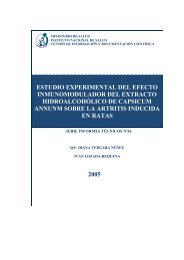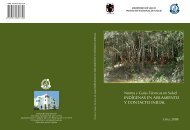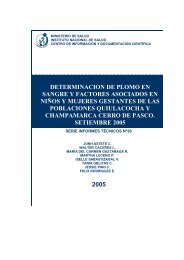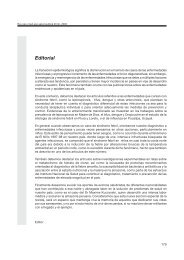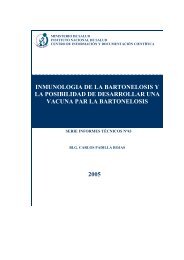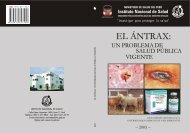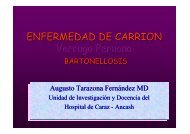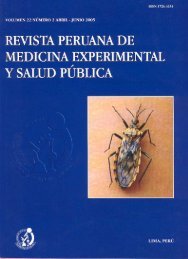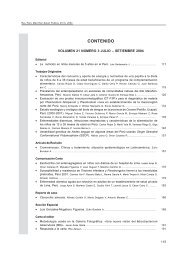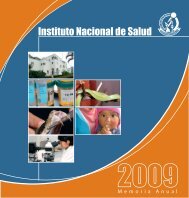rEViSta PErUaNa dE MEdiciNa ExPEriMENtaL y SaLUd PÚbLica ...
rEViSta PErUaNa dE MEdiciNa ExPEriMENtaL y SaLUd PÚbLica ...
rEViSta PErUaNa dE MEdiciNa ExPEriMENtaL y SaLUd PÚbLica ...
Create successful ePaper yourself
Turn your PDF publications into a flip-book with our unique Google optimized e-Paper software.
Rev Peru Med Exp Salud Publica 2007; 24(2): 129-35.<br />
1<br />
ReSUMeN<br />
TRaNSICIÓN NUTRICIoNaL eN eL PeRÚ, 1991 - 2005<br />
Mónica L. Mispireta 1a , ángel M. Rosas 1b , José E. Velásquez 1,2b ,<br />
Andrés G. Lescano 1,3c , Claudio F. Lanata 1,4a<br />
La transición nutricional es un proceso que incluye cambios en el perfil nutricional de las poblaciones. Muchos países<br />
en desarrollo, incluyendo Perú, se encuentran en transición. Objetivos: Describir la variación del perfil nutricional de<br />
los niños, madres en edad fértil y familias peruanas entre 1991 y 2005. Materiales y métodos: Usando la información<br />
disponible en las bases de datos de las Encuestas Nacionales Demográficas y de Salud realizadas en el Perú entre<br />
1991 y 2005, se describe la prevalencia de malnutrición en niños menores de cinco años, madres en edad fértil y<br />
familias peruanas a nivel nacional, regional, y de acuerdo al nivel socioeconómico y área de residencia (urbano/rural).<br />
Resultados: La tasa de retardo de crecimiento infantil se ha mantenido alta y constante desde 1996. El sobrepeso<br />
infantil se ha incrementando principalmente en Lima Metropolitana y la Costa. En las madres en edad fértil el<br />
problema más importante es la alta prevalencia de sobrepeso y obesidad, que se incrementa principalmente en Lima<br />
Metropolitana y la Costa. La coexistencia de retardo de crecimiento infantil y obesidad materna a nivel familiar ha sido<br />
baja y sin presentar alguna tendencia temporal en el período estudiado. Conclusiones: El perfil nutricional peruano se<br />
encuentra en transición. Sus principales componentes son la alta tasa de retardo de crecimiento infantil y el incremento<br />
en sobrepeso y obesidad materna. Estos hallazgos muestran que la población peruana presenta un alto riesgo de<br />
desarrollar enfermedades asociadas con ambos extremos de la nutrición.<br />
Palabras clave: Malnutrición; Obesidad; Encuestas demográficas; Perú (fuente: DeCS BIREME).<br />
abSTRaCT<br />
NUTRITIoN TRaNSITIoN IN PeRU, 1991-2005<br />
Nutrition transition is a process including changes in the nutritional profile of populations. Many developing countries,<br />
including Peru, are in transition. Objectives: The aim of this study was to describe the variation of the nutritional profile<br />
of Peruvian children, mothers in reproductive age and families between 1991 and 2005. Material and methods: using<br />
available information from databases from Peruvian Health and Demographic National Surveys, between 1991 and 2005,<br />
we described the prevalence of malnutrition in Peruvian children less than 5 years of age, mothers in reproductive age,<br />
and families, at the national, regional, and socioeconomic level, and by residence area (urban/rural). Results: Stunting<br />
in children has been high and constant since 1996. Overweight in children has increased, mainly in Lima and the Coast.<br />
Overweight and obesity are the main nutritional problems of mothers in reproductive age, which have increased in Lima<br />
and the Coast. Coexistence of child stunting and maternal obesity at the family level has been low and without specific<br />
trend. Conclusions: The Peruvian nutritional profile is in transition. The main components are the high prevalence of<br />
stunting in children and the increase of maternal overweight and obesity. This findings show that Peruvian population is<br />
posed at a high risk of developing diseases related to both extremes of nutrition.<br />
Keywords: Malnutrition; Obesity; Population surveys; Peru (source: DeCS BIREME).<br />
Instituto de Investigación Nutricional. Lima, Perú.<br />
2 Facultad de Medicina, Universidad Peruana Cayetano Heredia. Lima, Perú<br />
3 Naval Medical Research Center Dettachment. Lima, Perú.<br />
4 Escuela de Medicina, Universidad Peruana de Ciencias Aplicadas. Lima, Perú.<br />
a Médico epidemiólogo; b Médico salubrista; c Bioestadístico salubrista.<br />
aRTÍCULo oRIGINaL<br />
129



